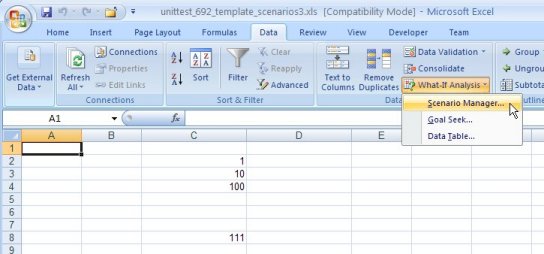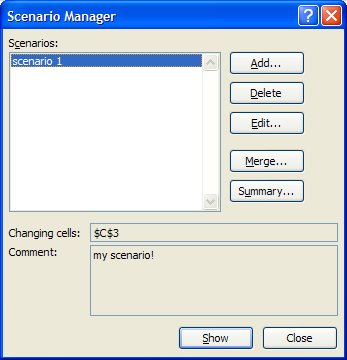| xlsgen > overview > Scenarios |

Scenarios is a feature in Excel for testing values in target cells in a spreadsheet where one or more input values are changed. In Excel, this feature can be accessed by going to the Tool / Scenarios menu option if you are using Excel 2003 or an older release of Excel, and can be accessed by going to the Data ribbon tab, What-if analysis and Scenarios menu option if you are using Excel 2007 or a more recent version of Excel.
Scenarios differ significantly over what-if tables in the sense that what-if tables are designed to test changes in formula values when one or more of its parameter are tested against other values expressed in a table, whereas scenarios input values are cells, and resulting values are not expressed in a table.

xlsgen supports the following scenarios capabilities :
Each sheet can hold one or more scenarios, defined by their names, a number of input values, and optionally result cells.
| Java code |
worksheet.putNumber(2,3, 1);
worksheet.putNumber(3,3, 10);
worksheet.putNumber(4,3, 100);
worksheet.putFormula(8,3, "=SUM(C2:C4)");
// one scenario
XlsScenario s1 = worksheet.NewScenario();
s1.putScenarioName("scenario 1");
s1.putScenarioComment("my scenario!");
s1.putScenarioResultCellsRange("C8:E8");
// one input value to be tested
XlsScenarioValue sv1 = s1.ScenarioAddValue();
sv1.putScenarioValueRow(3);
sv1.putScenarioValueColumn(3);
sv1.putScenarioValueAsFloat(20); // replace 10 with 20 (in the scenario only)
|
| VB code |
worksheet.Number(2,3) = 1 worksheet.Number(3,3) = 10 worksheet.Number(4,3) = 100 worksheet.Formula(8,3) = "=SUM(C2:C4)" ' one scenario Dim s1 As IXlsScenario Set s1 = worksheet.NewScenario s1.ScenarioName = "scenario 1" s1.ScenarioComment = "my scenario!" s1.ScenarioResultCellsRange = "C8:E8" ' one input value to be tested Dim sv1 As IXlsScenarioValue Set sv1 = s1.ScenarioAddValue() sv1.ScenarioValueRow = 3 sv1.ScenarioValueColumn = 3 sv1.ScenarioValueAsFloat = 20 ' replace 10 with 20 (in the scenario only) |
| C# code |
worksheet.set_Number(2,3, 1); worksheet.set_Number(3,3, 10); worksheet.set_Number(4,3, 100); worksheet.set_Formula(8,3, "=SUM(C2:C4)"); // one scenario IXlsScenario s1 = worksheet.NewScenario(); s1.ScenarioName = "scenario 1"; s1.ScenarioComment = "my scenario!"; s1.ScenarioResultCellsRange = "C8:E8"; // one input value to be tested IXlsScenarioValue sv1 = s1.ScenarioAddValue(); sv1.ScenarioValueRow = 3; sv1.ScenarioValueColumn = 3; sv1.ScenarioValueAsFloat = 20; // replace 10 with 20 (in the scenario only) |
| C++ code |
worksheet->Number[2][3] = 1; worksheet->Number[3][3] = 10; worksheet->Number[4][3] = 100; worksheet->Formula[8][3] = L"=SUM(C2:C4)"; // one scenario xlsgen::IXlsScenarioPtr s1 = worksheet->NewScenario(); s1->ScenarioName = L"scenario 1"; s1->ScenarioComment = L"my scenario!"; s1->ScenarioResultCellsRange = L"C8:E8"; // one input value to be tested xlsgen::IXlsScenarioValuePtr sv1 = s1->ScenarioAddValue(); sv1->ScenarioValueRow = 3; sv1->ScenarioValueColumn = 3; sv1->ScenarioValueAsFloat = 20; // replace 10 with 20 (in the scenario only) |
xlsgen documentation. © ARsT Design all rights reserved.